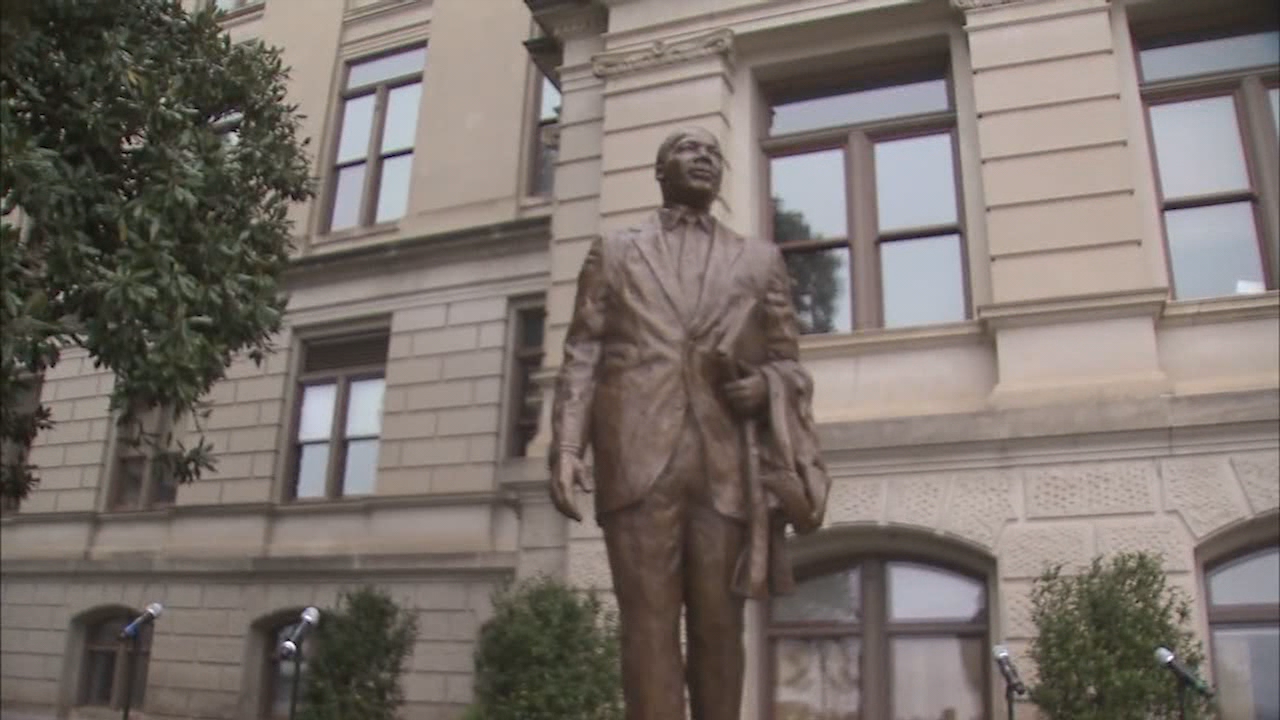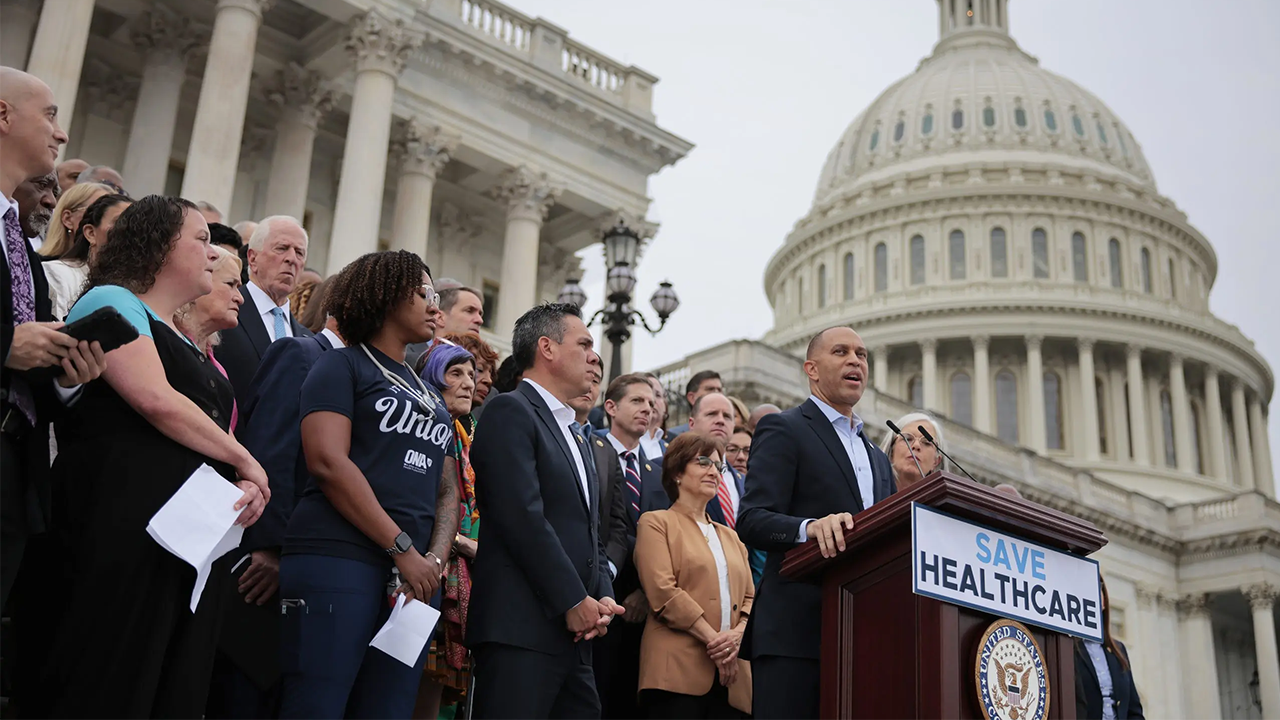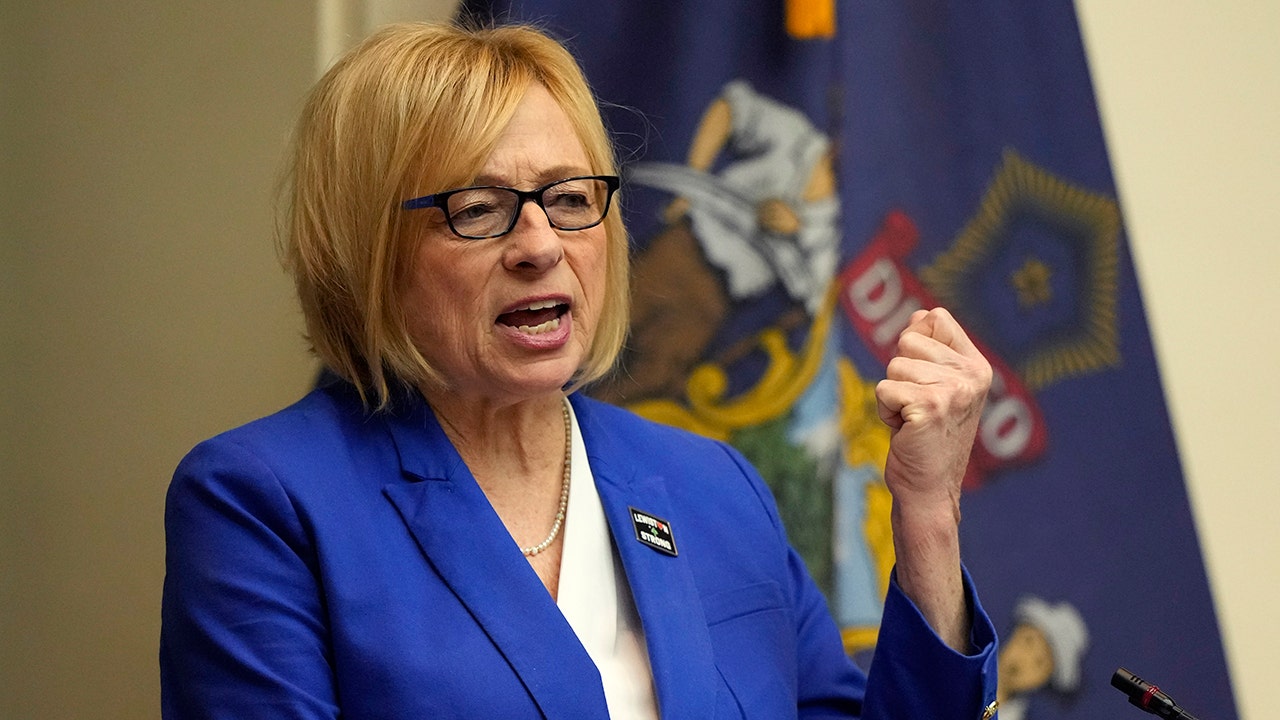When Donald Trump is inaugurated as president for the second time in January 2025, he will assume power over the regulation of a tech industry that’s changed significantly since his first term began in 2017. The tech industry’s honeymoon period with the US government has fizzled, and both Trump and his successor, President Joe Biden, took a skeptical stance toward tech CEOs, albeit for different reasons. Their antitrust enforcers initiated some of the first major anti-tech monopoly actions in decades.
Technology
What a second Trump presidency means for tech
/cdn.vox-cdn.com/uploads/chorus_asset/file/23951553/VRG_Illo_STK175_L_Normand_DonaldTrump_Negative.jpg)
Now, the tech industry has wised up. Most CEOs have looked back at the last eight years of techlash and seemed to conclude that they should be as visibly apolitical as possible — though they’re happy to lobby behind the scenes. At the same time, some have gambled that being in Trump’s good graces would be beneficial — and that risk seems to have paid off. Meta CEO Mark Zuckerberg, who Trump has literally threatened to send to prison, praised the president-elect’s fist pump after the attempted assassination and has made nice with Republicans about Meta’s content moderation choices. Amazon founder and Washington Post owner Jeff Bezos killed an endorsement of Kamala Harris in the paper. And, of course, Tesla CEO and X owner Elon Musk has made himself one of Trump’s chief allies, securing a promise that he could run a “Department of Government Efficiency” (DOGE).
Trump, meanwhile, will have more power than ever — he’s rooted out former supporters who encouraged restraint during his first term, and key allies have sprawling plans for overhauling the administrative state.
All this to say, the next four years of tech policy will be unpredictable and erratic. But even as Trump tries to expand his authority, he’ll need support from the courts and Congress. These are the policies we’ll be tracking as Trump reassumes the presidency and what he could realistically do.
AI
A Trump presidency likely means a less constrained AI industry. Trump has promised to repeal the Biden administration’s AI executive order, which instructed agencies to create testing standards and guardrails to prevent AI from being used in discriminatory ways, like in allocating housing or determining legal outcomes in the criminal justice system. Trump previously signed his own executive order covering AI safety and standards, but it did not touch on discrimination. The second Trump administration will likely deprioritize AI discrimination safeguards and discourage the use of the Defense Production Act to require more transparency, something conservatives have characterized as government overreach.
AI policy is an area where Elon Musk will likely seek to exert his influence, assuming he and Trump remain on good terms. Musk runs xAI and has been critical of incumbent players like OpenAI — a firm he cofounded but later distanced himself from and sued. Musk has supported AI safety measures like California’s controversial and ultimately vetoed SB 1047, and he previously signed a call for a moratorium on major AI developments for safety reasons. But his focus on existential risks has been criticized by some AI researchers as a distraction from more immediate risks like discrimination.
AI policy is an area where Musk will likely seek to exert his influence
It’s also not yet clear how Trump will handle thorny copyright issues surrounding generative AI, including what information large language models are allowed to train on. AI executives, including Musk, could seek to shape how Trump views the issue in a way that’s favorable to them.
Antitrust
Trump’s approach to antitrust enforcement could be based mainly on personal grievances. Bloomberg Intelligence senior litigation analyst Jennifer Rie writes that “enforcement could be idiosyncratic based on president-elect Donald Trump’s view of the companies or industries involved.” Adam Kovacevich, CEO of the left-of-center tech industry group Chamber of Progress, bluntly said we’ll see a “‘Trump Welfare Standard’: is this company nice to Trump?”
Though Trump’s VP pick, JD Vance, has publicly praised Federal Trade Commission Chair Lina Khan, it’s not clear how committed Vance is to this stance or how much sway he will have. If he does get a say here, we could expect a continued crackdown on big tech firms to benefit “little tech” or startups that VCs like Andreessen Horowitz (another Trump supporter) want to see rocket with growth.
“Republicans no longer uniformly lean more business-friendly than Democrats.”
While business leaders may be relieved if Khan leaves the FTC, Rie says we shouldn’t expect “a return to the relaxed antitrust climate of 10 years ago … some aspects of the current aggressive approach will stick. Republicans no longer uniformly lean more business-friendly than Democrats.” Still, while she says it largely depends on Trump’s appointments, merger approvals could become swifter and recently revised merger guidelines could be unraveled.
Trump’s administration will likely continue the existing legal fights against Meta, Google, Apple, and Amazon (including two cases filed during Trump’s first term). But it could pursue more modest remedies, depending on who he appoints — and how Trump feels about a company like Google on any given day. “A slight increase in settlement prospects is possible down the road, especially if the cases don’t seem to be going well for the agencies,” Rie writes. “Trump doesn’t believe Google should be broken up, though we didn’t expect this to happen anyway.” Kovacevich also says Trump could use the cases “as leverage over the companies to get favorable treatment on speech and content concerns.”
TikTok
Perhaps Trump’s greatest flip-flop issue has been his stance on TikTok. Trump championed the original TikTok ban effort, which was shot down by the courts. But he’s more recently said he opposes a ban because it would just benefit Meta. Trump’s turnaround reportedly came after he met with Republican donor Jeff Yass, who has a major stake in ByteDance.
Under the Biden administration, Congress overwhelmingly passed a bill that could ban the social video app unless ByteDance divests it by mid-January, and Biden signed it into law. The DC Circuit Court of Appeals is currently deliberating about whether that law can be upheld and will likely release a decision by the end of the year. But TikTok’s chances of dodging a ban only “slightly” improve under a Trump presidency, according to Bloomberg Intelligence litigation analyst Matt Schettenhelm.
The law doesn’t give Trump “much room” to play with
If the DC Circuit decides to uphold the law and the Supreme Court declines to take it up or upholds that ruling, what Trump can do is somewhat limited. He could grant an extension of up to 90 days for ByteDance to complete its divestiture of TikTok, but under the law, he would need to certify to Congress that there’s an actual plan underway. The law does leave the president some discretion to determine whether more apps besides TikTok fall under the divestiture law’s purview and what represents an adequate separation. But TikTok is written into the statute, so Trump can’t just decide it no longer applies.
The law doesn’t give Trump “much room” to play with, Schettenhelm tells The Verge in an email, though he could exercise some judgment in approving TikTok’s divestiture proposal. Even if Trump took the “unusual” step of announcing his Justice Department wouldn’t enforce the law, Schettenhelm writes in a note to clients, “companies that carry the app would be undertaking enormous risk that Trump wouldn’t change his mind and seek crippling penalties. We doubt they’d do so.”
If the court strikes down the law — perhaps because it finds it violates the First Amendment or because Congress didn’t develop a strong enough record in the relatively quick lead-up to its passage — then the legislature would need to do the process over. While the bill had very strong bipartisan support the first time around, now that Trump has said he opposes a TikTok ban, it seems less likely Congress would spend valuable time on a bill that the president may not sign.
Tariffs and China
Trump famously started a trade war with China in his first term in office, and if his campaign rhetoric is to be believed, we’ll see a continuation of such economic policies this time. While Biden has implemented some protectionist economic policies, including export controls on advanced semiconductors, Trump has floated tariffs on goods imported from China at a rate of 60 to 100 percent.
That could have big implications for the many tech companies that use components made in China and for any companies that rely on China for a significant part of their business strategy (like Apple and Tesla). But because of that connection, this is another area where Elon Musk’s influence could be a wild card.
Alongside his promises of mass deportations, Trump’s China tariffs could dramatically change day-to-day life in America, as severe price hikes for imported goods would throw countless people’s lives and livelihoods into chaos. How far the administration will go is an open question, and one that makes predicting the future with any certainty — inside and outside the tech industry — difficult to do.
Net neutrality and telecom policy
Net neutrality — which already faces an uphill battle in the courts after SCOTUS rolled back Chevron deference — is likely dead under a Trump administration. Bloomberg Intelligence analyst Nathan Dean predicts a 90 percent chance Trump’s Federal Communications Commission abandons the effort to reclassify broadband providers as common carriers and subject them to greater regulatory scrutiny.
A Republican-led FCC will also likely allow more concentrated control of TV stations, Dean writes, and loosen broadcast merger and acquisition rules. Republican FCC commissioner Brendan Carr, who served during the first Trump administration, has called for big tech companies to pay into the Universal Service Fund — currently funded by telecommunications providers — and suggested punishing TV networks under broadcasting rules.
Musk could seek to limit programs that help Starlink’s competitors
It’s not totally clear yet how Trump’s FCC will handle other key broadband policy issues, including the rollout of the government’s Broadband Equity, Access, and Deployment (BEAD) infrastructure investment program. But once again, Elon Musk’s influence could become important here. Musk runs the satellite internet company Starlink, which has been passed over for some government contracts, but could lobby for more favorable policies under Trump. For example, the BEAD program currently favors fiber broadband, and Musk has critiqued the program as an “outrageous waste of taxpayer money.”
In his government efficiency role or in a more informal way, Musk could seek to limit programs that help Starlink’s competitors, like the Universal Service Fund, according to CNET. That program helps service rural communities with broadband — places where Starlink is well positioned to move in.
Content moderation
Conservatives including Trump have long complained about social media platforms suppressing conservative speech and accused them of bowing to Democratic government pressure to remove things like election or vaccine misinformation. Even before his reelection, platforms like Meta had heeded Republican pushback and loosened their moderation standards.
A Trump administration and Republican legislature could rework the Section 230 liability shield to let them actually punish companies for moderation decisions. In addition to the option of passing actual laws changing Section 230, Brendan Carr suggested in his Project 2025 chapter that the FCC could narrow its protections for a broad range of content moderation decisions. Ultimately, any executive or legislative changes to online speech rules could face the Supreme Court, which has so far upheld the right to conduct content moderation, although it signaled openness to potential legal changes in the future.
Kids online safety
Trump hasn’t said much about where he stands on this topic or on the leading congressional bill on the subject, the Kids Online Safety Act (KOSA). That bill remains stalled in the House after passing through the Senate (in combination with an update to children’s data privacy law), and it’s not yet clear what could happen in future congressional sessions. Current Republican House leadership has expressed concerns that KOSA could unduly limit speech, so a Democratic House might be more open to giving it floor time, but ultimately, the concerns with the bill don’t fall entirely down partisan lines.
Adam Kovacevich, whose group has opposed KOSA, suggests Democrats should be wary of passing the bill under a Trump presidency — pointing to lead cosponsor Sen. Marsha Blackburn’s (R-TN) comments about protecting kids from transgender content online. “Democrats will have to decide whether they want to hand Trump & MAGA state law enforcers a powerful new censorship tool,” he writes.
Electric vehicles
Electric vehicle tax credits and other climate-focused policies will likely be in jeopardy under Trump, though that might be somewhat complicated by his connection with Musk, with Tesla standing to gain from EV-friendly policies. Still, Wedbush analyst Dan Ives previously said that Tesla’s “scale and scope … could give Musk and Tesla a clear competitive advantage in a non-EV subsidy environment.”
Tesla’s “scale and scope … could give Musk and Tesla a clear competitive advantage in a non-EV subsidy environment”
Bloomberg Intelligence analyst Nathan Dean sees just a 30 percent chance of continued EV tax credits under Trump. He predicts continued rhetoric that EVs are “a boon to China’s economy,” alongside efforts to replace the tax credits with consumer incentives that could benefit traditional carmakers like General Motors, Ford, and Stellantis.
Semiconductor policy
Under the Biden administration, Congress passed the bipartisan CHIPS and Science Act, which injected funds into creating a domestic semiconductor production industry — something experts say is a national security necessity and critical to maintaining control over the supply chain for important technologies including medical tech. But Trump called the bill “so bad” during his appearance on Joe Rogan’s podcast, and soon after, House Speaker Mike Johnson (R-LA) said he was open to repealing the law (though he later walked back those comments). Trump can’t undo a law on his own, but he could perhaps instruct his Commerce Department to slow-walk aspects of its rollout.
Crypto
Trump has made significant overtures to the cryptocurrency industry, headlining a major Bitcoin conference this summer and picking up significant support from prominent crypto investors like Marc Andreessen and Ben Horowitz. With Trump’s election, the industry is likely to get its top wish: the ouster of Securities and Exchange Commission Chair Gary Gensler, whom the industry views as its chief antagonist. Expect more permissive and hands-off regulation of this industry, as Trump has called for making the US a “Bitcoin superpower.”

Technology
Is the Coros Nomad really an adventure watch?

Coros’ Nomad is marketed as a “go-anywhere, do-anything” adventure watch. It’s got GPS and offline maps and will track a lot of activities, from yoga to bouldering. There’s an “Adventure Journal,” which the marketing copy promises will help you record “every step, catch, and summit.” While it doesn’t have some of the bells and whistles of a more expensive competitor like Garmin, it’s a product seemingly aimed at campers, backpackers, and other outdoorsy types who aren’t satisfied with something all-purpose like an Apple Watch. So when my colleague Victoria Song flagged the Nomad to me, I took Coros at its word — and, as The Verge’s resident dirtbag, took the Nomad on the Tahoe Rim Trail.
Outdoor recreation is a growing market. Notably, the market can afford smartwatches — the number of participants who make more than $100,000 a year is increasing, according to the Outdoor Industry Association. Hiking is the most popular activity.
Why aren’t hikers and trail runners demanding more from these products?
And backpackers, especially weight-obsessed thru-hikers, are absolutely deranged gearheads. Gear was the most common subject of discussion among hikers when I was on the Appalachian Trail earlier this year. Go to any backpacker forum and you’ll see the same thing. A really well-designed device isn’t going to need much marketing — word of mouth was enough to get me to try out the Haribo Mini Power Bank, the lightest 20,000mAh battery on the market and possibly also the cutest. There’s also lots of room to beat the price of Garmin smartwatches — the high-end models cost more than a grand. The Instinct 3, a comparable Garmin watch, is $399 at the absolute cheapest, even though you can’t download maps for navigation on that watch like you can with the Nomad. I haven’t owned a Garmin watch in about 10 years, largely because I just didn’t find the watches to be worth the price tag.
Photo by Liz Lopatto / The Verge
I used the Coros Nomad, which costs $349, on my hike and for a month of training beforehand. I am about to identify a bunch of limitations for my specific very outdoors sports, but before I do that, I want to be clear: this is a good watch at a great price. But I got the sense it was designed by and for weekend warriors (or maybe just suburban distance runners?).
There’s a world where someone delivers everything the Nomad promises — but the Nomad itself doesn’t. This is a failure of marketing, obviously, but it got me thinking. Why aren’t hikers and trail runners demanding more from these products? Even the most “outdoorsy” ones are still primarily meant for road runners.
Let’s just get it out of the way: the battery life kicks ass, especially in comparison to my Apple Watch Series 6. (Unlike some of our reviews team, I am a technology normal and use things until they break, pretty much.) The Tahoe Rim Trail is officially 165 miles, though the FarOut map I used for navigation put it at 174. I created — and mostly stuck to — an 11-day itinerary. I charged the Coros Nomad before I left, then wore it nonstop for the entirety of the hike. It ran out of battery once, near the end of day 6, at mile 19 of 25, after more than 40 hours of actively tracking my hikes. After a recharge, I didn’t need to charge it again for the rest of the hike. Not bad.
But my first clue that the Nomad hadn’t really been designed for me happened as soon as I opened the Coros app. The defaults on that app give you a sense of who it’s for, and the third section down, after the “Today” data and the training calendar, is a prompt for creating a personalized marathon plan. Coros’ displays are admirably customizable, so removing the marathon plan section was easy, but I had nothing comparable to replace it with. In fact, while the watch has a lot of features for road and track runners, they don’t tend to generalize to people who hike, backpack, or even do trail running — a major missed opportunity.
The outdoorsiest runners aren’t getting the same kinds of training insights as their road runner brethren.
The app had a prompt for a running fitness test, but it only works in “run” or “track run” mode, suggesting it’s not really geared toward trail runners. Road and track running are primarily about pace. Trail running generally involves dodging obstacles, dealing with uneven or loose ground, and longer, steeper climbs. That makes pace less of a priority, partly because of the increases in agility, balance, and strength demands. My guess, based on the fact that trail running, as a specific activity, is excluded from running fitness tests, is that Coros knows the “fitness test” won’t be accurate for trail runners. That’s frustrating in an “outdoors” watch — it means the outdoorsiest runners aren’t getting the same kinds of training insights as their road runner brethren.
Likewise, while there is an “auto pause” feature available for runners, it doesn’t work for hiking and walking — which is weird. My Apple Watch doesn’t have a problem noticing when I’m not moving. (There is a “resume later” mode if you want to track multiday activities in one track; I didn’t use it because breaking my hike into segments by day made more sense to me.)
I also found myself frustrated by the training calendar. While I could enter my strength routine and my trail runs, I couldn’t add hikes. The upside of the training calendar was that I could summon a specific workout on the Nomad as I did it — so if I was doing an interval run, the watch would notify me when each interval was over. For road and track runners, there are even preloaded workouts you can add, rather than painstakingly programming your own. Sadly, there wasn’t anything comparable for trail runners.

Photo by Liz Lopatto / The Verge
The watch did well at tracking walks and runs, of course. Both the distance and the altimeter seemed accurate when I tested them against my Apple Watch — I got roughly the same readings. But the default watch display on hiking was five screens of data. On the first page, it gave distance and speed, with the amount of time spent doing the hike in a bar near the bottom. The second page contained my heart rate and the time of day. The third page was Coros metrics — training load, as well as how efficient it felt my aerobic and anaerobic training was. The fourth page was lap (which in this case just meant mile) time, how far I’d gone until the next mile, and my speed. The final screen was the grade, my elevation gain and loss.
This is nonsense. I am simply not going to scroll though that many screens on a hike. That Coros’ made-up metrics take precedence over elevation and speed seems like a crucial error of judgment.
If the watch can’t contact a satellite on its own, it’s no good in the wilderness as an SOS device
On any given day I’m on trail, I need to know roughly what my overall per-mile pace is, what my current pace is, how many miles I’ve traveled, and when the sun is going to go down. (It’s nice but not necessary to know my overall elevation gain — when combined with information from mapping apps, it can tell me how close I am to being done with climbing for the day without me pulling out my phone.) So I consolidated the screens of data to two useful ones. But the tradeoff for easily changeable widgets is that the watch isn’t designed to be readable at a glance. Maybe it’s just my middle-aged eyes, but the combination of the display and the relatively small fonts meant I was squinting at the watch more often than I should have been — especially given that it was taking up so much real estate on my wrist. A less modular display might have created room for more readable design.
But perhaps the most damning thing about the Nomad and the Coros app is how much they rely on being connected to the internet. The biggest failure is that the Nomad marketing copy advertises safety alerts that allow the watch owner to send an SOS — but without cellular data, they don’t work. If the watch can’t contact a satellite on its own, it’s no good in the wilderness as an SOS device. (Most watches can’t connect directly to satellites, though some new models will.) My problem here is the marketing: if you are promising that the watch is for going anywhere, the safety alert feature you’re advertising had better go anywhere, too.
In the Sierras, there are often afternoon thunderstorms, and while I was on the Tahoe Rim Trail, I had five straight days of them. (On the first one, I even got hailed on.) I had a 25-mile day not because I meant to walk 25 miles, but because I’d gotten most of the way up to the highest point on the trail, Relay Peak, when a thunderstorm began. I looked around at trees near me that had obviously been struck by lightning at some point in the past, decided that discretion was the better part of valor, and began heading back down.

I’d gotten most of the way down when the thunderstorm passed, and then I had a decision to make: was I going to try to get over the mountain again? This wasn’t really a decision the Nomad could help me with. My Garmin InReach Mini 2 had helpfully informed me that there was, indeed, another thunderstorm on the way — it will work as long as it has a view of the sky, though a weather report will cost you one of your expensive text messages. The Nomad, on the other hand, pulls most of its data from Apple’s Weatherkit API, which means it only works if your mobile phone has service, so if you’ve put your phone in airplane mode to conserve battery or you don’t have service at all, you’re out of luck. So if you’re trying to stay safe by planning for the weather, the Nomad doesn’t really cut it in the backcountry.
I did make it up and over Relay Peak before the next storm began, a deluge that soaked me to the skin despite my rain gear. But I had plenty of time on the down slope to wonder, soggily, if it would have been helpful to have gotten a storm alert before the first thunderstorm started. I found out after I got back to civilization that it was, in fact, possible to get a storm alert — the Nomad has a built-in barometer. Unfortunately, it was buried in a menu I hadn’t explored, and the storm alert defaulted to off.
I know that a lot of people enjoy fooling around with every menu and setting on their gadgets, but personally, I’d rather hike
I don’t expect Coros to entirely retool its app to prioritize backpackers. But it might have been helpful to get some of these details in a one-sheet with the Nomad quick-start guide: how to turn on weather alerts, how to test for altitude acclimation, that the SOS service and weather require cellular data. I know that a lot of people enjoy fooling around with every menu and setting on their gadgets, but personally, I’d rather hike. Pointing me at what might be useful would help me with that goal.
If the company wanted to invest more in training plans for trail runners, hikers, and backpackers — or, at minimum, allow people to add planned hikes to their workout calendar — that would be great. But there are other ways the Nomad fails the outdoors athlete.
As I was getting ready for the trail, I brought the watch to all my workouts, which is unusual. Generally I reserve activity tracking for cardio activity, because watches are pretty good at tracking that, and pretty bad at most everything else. But with its training load metrics, its recovery timer, and its sleep focus, the Coros app suggests the company’s devices can be used to foresee a person’s needs doing fairly complicated activities.
Unfortunately, these activities are pretty idiosyncratic.

The Coros app is somewhat successful at estimating training load for cardio, but the limitations around how it handles other activities make the “insights” suspect. The training load is based on duration and heart rate — which means for non-cardio activities, it’ll skew low. This data is then used to set a recovery timer, which is supposed to tell you how long it’ll take before you’re back at 100 percent. Because the training load isn’t based on reliable data for non-cardio activities, the recovery timer isn’t trustworthy either.
These problems aren’t unique to the Nomad; the Apple Watch (and pretty much every wearable fitness tracker) sucks at tracking this stuff, too. But it doesn’t try to give me recovery metrics or in-depth training insights.
Like most sports watches, the Nomad wasn’t very good at handling my strength training or yoga. The bouldering settings struck me as more useful. The watch will cue you to handle your first problem; when you’re finished, you click one of its buttons, and can then enter how you tackled the climb, using the sport’s specialized jargon. Afterward, you can see your total ascent, how long you rested between problems, and the grade you climbed at — as well as some less useful data, like heart rate. But with all three sports, the watch had trouble telling how much I’d exerted myself.
On trail, the Coros recovery timer wasn’t much better. After the first day, according to the watch, I was fatigued and needed to rest. The recovery timer stayed there throughout the duration of the trip. There were days I woke up feeling fresh and ready to go, and then glanced at the Coros app, which told me I was at 0 percent of my capacity. That felt silly, especially when I’d then knock out 15 miles.
And despite all the workout modes the Nomad offered, there was an important one missing: rucking, or walking with weight. That’s the key feature of backpacking. The Apple Watch doesn’t offer rucking, either. Whoop also has a rucking mode, but doesn’t track weight. Coros’ direct competitor Garmin introduced a rucking mode earlier this year, allowing users to track their pack weight, and while its features leave some things to be desired, it’s a start.
The promised personalized training programs Coros’ app offers simply don’t fit anything I’m doing
It’s weird that rucking is so thoroughly ignored. Bro influencers, from Andrew Huberman to Peter Attia, have been singing its praises; GQ named it “the workout of 2024.” Axios notes it’s on the rise among women, too; Women’s Health highlighted its beneficial effects on bone density. Even Tom’s Guide has called it a “game changer.” Look, I consider myself a backpacker rather than a rucker, but whatever you call it, this is an underserved market.
The promised personalized training programs Coros’ app offers simply don’t fit anything I’m doing. To train for a thru-hike, I typically do trail runs and rucks using my actual backpack. On most workdays, I’m not going to be able to get in even a 10-mile hike, so running is important for my cardio capacity. As for rucking, that’s partly to get my feet used to the demands of the extra weight. The goal is to ruck with either my maximum pack weight or more for the month before my hike.
I will spare you the details of hiker math, but here’s the bare outline: I knew my gear alone would be 16.2 pounds; that I’d need to carry about 5 liters, or about 10 pounds, of water at maximum; and that water carry would be when I was also carrying four days’ worth of food, or about 8 pounds. My pack, at its absolute heaviest, would weigh about 32 pounds.
That meant when I did training hikes, I loaded up my backpack until it weighed 35 pounds. Those hikes were largely vibe-based — I usually climbed a minimum of 2,000 feet over 10 miles as quickly as I could. But while I was training, I had plenty of time to fantasize about how a backpacker-oriented fitness watch could make my life easier. Here’s what I came up with:
- Separate VO2 max to let me track my improvements
- Field to let me enter how much I’m carrying
- Suggestions for when I might be able to go up in weight safely
- Suggestions for when I might be able to add mileage safely
- The ability to generate a training plan for an end goal — for instance, automating the backpacker math I just did, and then generating a plan for getting from a user’s current level of fitness to, say, hiking 20 miles with 35 pounds of weight, with 3,000 feet of elevation gain. Ideally this would involve a mix of rucks and runs.
Sure, there are a limited number of thru-hikers who are going to be doing this particular style of training — but it will also benefit the much larger number of people who ruck for fitness. And who knows? If a smartwatch came up with a good couch-to-thru-hike app, it might catch on just like couch-to-5K.
On both the Nomad and the Apple Watch, I tracked my hikes as “walks” and my hikes with weight as “hikes.” That helped me separate the activities at a glance. But there were still some annoyances. On the Apple Watch, both my hikes and walks counted toward my estimated VO2 max, which is an indicator of aerobic fitness that is particularly important to endurance athletes — and while the actual value is kind of a bullshit metric that will vary pretty wildly between watches, the trend line is what I’m watching. When I’m hiking with weight in preparation for a backpacking trip or on the trip itself, my VO2 max takes a hit. When I stop hiking with weight after the trip, my VO2 max shoots up. Garmin gets around this problem by disabling the VO2 max when its watches are in rucking mode.
The Nomad’s VO2 max is buried in the “Running Fitness” menu, a feature I didn’t click on for a very long time because, well, it turns out there’s no data available for me since I’m not a road or track runner. Neither walks nor hikes count toward that score — and neither do trail runs.

I understand the Nomad added offline street names to its GPS navigating capabilities, which was basically meaningless to me — there aren’t a lot of streets where I go. The watch’s screen wasn’t big enough to be my main source of navigation; FarOut is pretty tough to beat, not least because it can do things like tell you if a water source is still running even if you don’t have service. It’s also difficult to get lost on the Tahoe Rim Trail, which is well groomed and clearly signed. Perhaps if I had made camp and gone for a day hike, it would have been more useful in retracing my steps back to camp. Still, I didn’t see any obvious flaws using it, and I was impressed by the lack of lag.
The map the Nomad generates can be used as the backbone of its Adventure Journal function. This is the distinguishing feature of the Nomad, which lets you add photos and voice notes made on the Nomad watch — it’s got a built-in microphone — to your recorded activity.
Sadly, it, too, does not work unless you are connected to the internet. This limits its on-trail usefulness.
Like many other Coros features, it’s not exactly easy to find the voice note function from the activity screen

For ultralight types, keeping notes in your phone is good enough. I carry a notebook and pen — luxury items, but fairly flexible ones. I keep a trail journal on the days I don’t immediately fall asleep as soon as I lie down in my tent. (It’s a nice way to wind down.) I also use it to sketch out my intended route, make shopping lists for my resupply runs, and, in a pinch, leave a note on the dashboard of my car saying when I expect to be back from my trip. For the kind of hiker who doesn’t want to bring a pen (0.3oz) and notebook (5.4oz), it might serve as an upgrade over trying to type on a phone.
Writing in my journal is a habit; making voice notes is not. So while I was hiking the TRT, I did not use the microphone, because it simply did not occur to me. To be honest, I’m not sure what notes I’d make on a thru-hike that need to be coordinated to a specific point on trail. The voice notes feature is probably most useful for people who hunt and fish, or birdwatchers. Like many other Coros features, it’s not exactly easy to find the voice note function from the activity screen — but once I located it, it worked well enough.
The photo feature was more intuitive. You can take photos in the Coros app, though I didn’t; I find it easier to take photos without unlocking my phone. Because I went so long without an internet connection, I was dreading dealing with the backlog, but uploading the images to my activities was fairly effortless — and when I sent some of my travelogue to my friend Rusty, he didn’t have any trouble seeing both my route and my photos.
The real question around the Adventure Journal was how much it locks your notes into the Coros system, and the answer is: at least a little. I was able to export the data from my last day, and then upload a GPX of the hike to CalTopo, one of my favorite mapping programs. Though the data included my pins — the spots where I’d taken pictures — the pictures themselves were not included.

I agree with a lot of straightforward hardware reviews about the Coros Nomad — the battery life is fantastic, the watch itself is relatively light and can take a beating, the offline navigation works very well (for a watch — screen limitations are always going to matter), and it’s appealingly cheap. It’s a tremendous upgrade over my current watch in those respects. While a flashlight or solar charging would be nice, they’re not necessities. No, it’s the software I have beef with.
As far as I know, there hasn’t yet been a truly great backpacker watch, and the Nomad definitely isn’t it. The Adventure Journal is a neat toy, but not much more. The software fixes that could get the Nomad over the line might include training programs for trail runners and backpackers, a rucking mode (ideally with better support for rucking than the relatively paltry offerings by its competitors), and a more considered recovery program. Even simpler fixes — highlighting the capabilities that the Nomad does have but are buried in a non-intuitive menu, an easier-to-read design in activity modes, an app that does more when it’s offline — would be improvements.

But let’s dream for a minute, because the Nomad really got me thinking about what an ideal outdoor watch could do. Obviously, the battery life and GPS navigation are nonnegotiable. But the one hardware modification that could really change the game is satellite connectivity. I know it’s possible to connect to a satellite via a watch because the Apple Watch Ultra 3 offers it — but that watch only has an estimated 72 hours of battery life in low-power mode, and it’s $800. The new Garmin Fenix 8 Pro also offers it along with roughly 27 days of battery life, but it requires a subscription on top of its absurd starting price of $1,200.
A watch that lets me drop the Garmin InReach Mini (3.5oz) has benefits beyond the weight savings and letting me cancel an expensive subscription: I am less likely to lose my watch in a fall than I am to lose the Garmin device, even if it’s clipped to my belt loop. A watch that lets users send a real SOS — as well as check-in notifications — is going to be much more of a game changer than solar charging, flashlights, music, or wallets. Add alerts for severe weather, and you’ve got a winner. That’s safety gear, and no one in their right mind skimps on that in the backcountry. People are going to buy Garmin’s Fenix 8 Pro, despite the eye-watering price and subscription, for exactly this reason. Shit, I might be one of them when I need to replace my InReach — even though the Fenix 8 Pro is stuffed with features I don’t want or need, like speakers, a voice assistant, preloaded golf course maps, and dive functionality. I’d love a better, cheaper alternative.
A watch that lets me drop the Garmin InReach Mini (3.5oz) has benefits beyond the weight savings and letting me cancel an expensive subscription
When I am on a solo hike, people are consistently surprised that I — I’m openly female — feel safe enough to hike alone. Thru-hiking is pretty male-dominated, and a lot of effort goes into assuring women that we are fairly safe outdoors. I wonder how many other women might try their first solo hike if they knew they could easily summon help by pressing a button on their watch. Probably a lot! And I bet there are a lot of women road runners out there, especially in rural areas, who would benefit from knowing they can summon help without cell service too.
This is maybe a prime example of how designing gear for the most intense users also expands the market. That’s the norm for this sport. Ray Jardine pretty much revolutionized backpacking by cutting weight and kicked off the ultralight movement. Ultralight gear made the sport more accessible to women, older people, and people with injuries, increasing backpacking’s popularity. Thinking about thru-hikers and trail runners — especially ones who are training for the more maniacal races, such as 100Ks — is like making basketball shoes for LeBron James. Ideal gear will matter more to LeBron, but the average high school player stands to benefit too.
So: is the Nomad a good watch? Yes, in some ways, if you’re comparing it to current offerings from Apple or Garmin — especially in its price range. But it doesn’t live up to its marketing campaign of letting you go anywhere and do anything. The reasonably affordable watch that will do that for the world’s most deranged gearheads doesn’t exist. At least, not yet.
Technology
Arizona sheriff’s office utilizing new AI program to assist with writing case reports
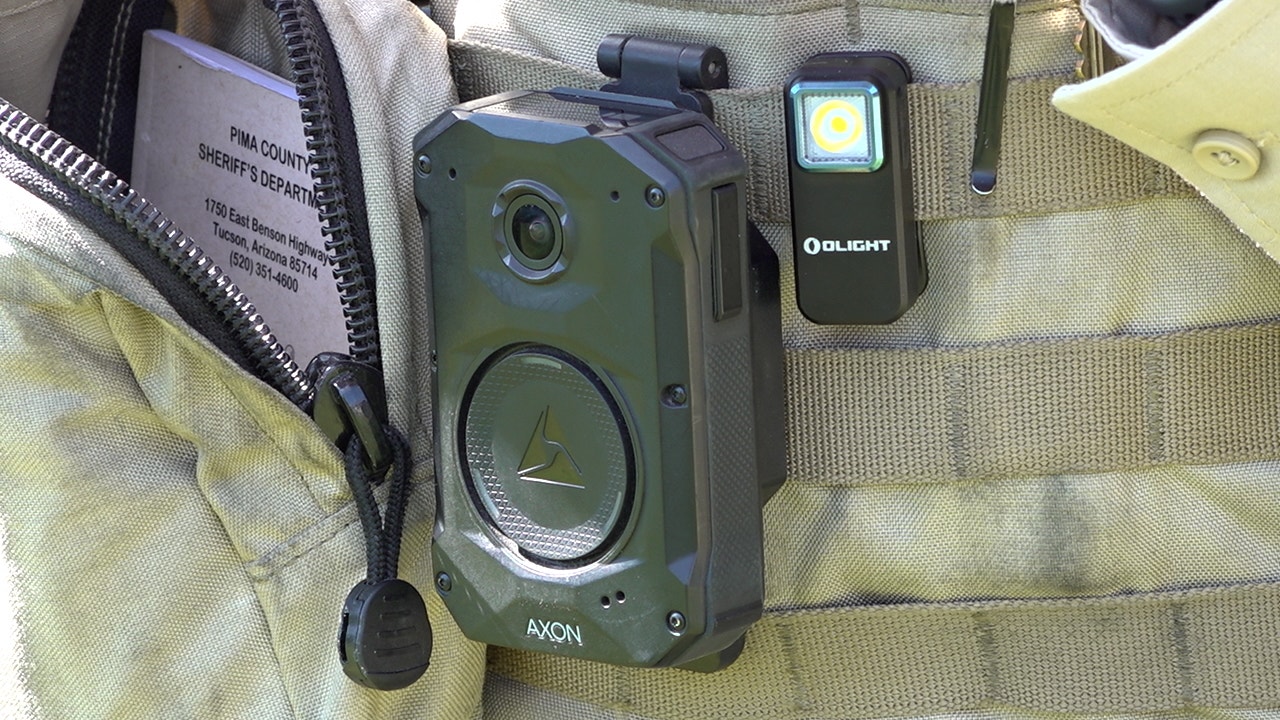
Law enforcement agencies turn to A.I.
As artificial intelligence becomes more mainstream, the Pima County Sheriff’s Department in Arizona is looking at how it can use the emerging technology. Since the start of the year, deputies have been testing a program called Draft One, from Axon.
NEWYou can now listen to Fox News articles!
TUCSON, Ariz. – As artificial intelligence becomes more mainstream, the Pima County Sheriff’s Department is looking at how it can use the emerging technology.
At the beginning of the year, deputies began a trial of Axon’s Draft One, which is a program that writes incident reports using AI. A body camera records the interactions, then the program uses the audio plus any additional information from the deputy to create a first draft. Deputies then review everything before submitting the final report.
“They’re able to verify the completeness, the accuracy and all of that,” Capt. Derek Ogden said, “But the initial first draft, they can’t submit as their case report.”
Demonstrating the program, Deputy Dylan Lane showed how Draft One can write a case report that would have taken him 30 minutes to complete in five minutes.
CHATGPT MAY ALERT POLICE ON SUICIDAL TEENS
A Pima County deputy opens Draft One to begin writing his case report. After it’s finished, he will check it for accuracy before submitting it. (Amalia Roy)
“Most of that time is just the quick changes, making sure that all the information is still accurate and then just adding in those little details,” Lane said.
Ogden said Draft One saves crucial time during shifts when deputies are handling multiple incidents back-to-back. He said the program is one of several ways the department is exploring AI tools.
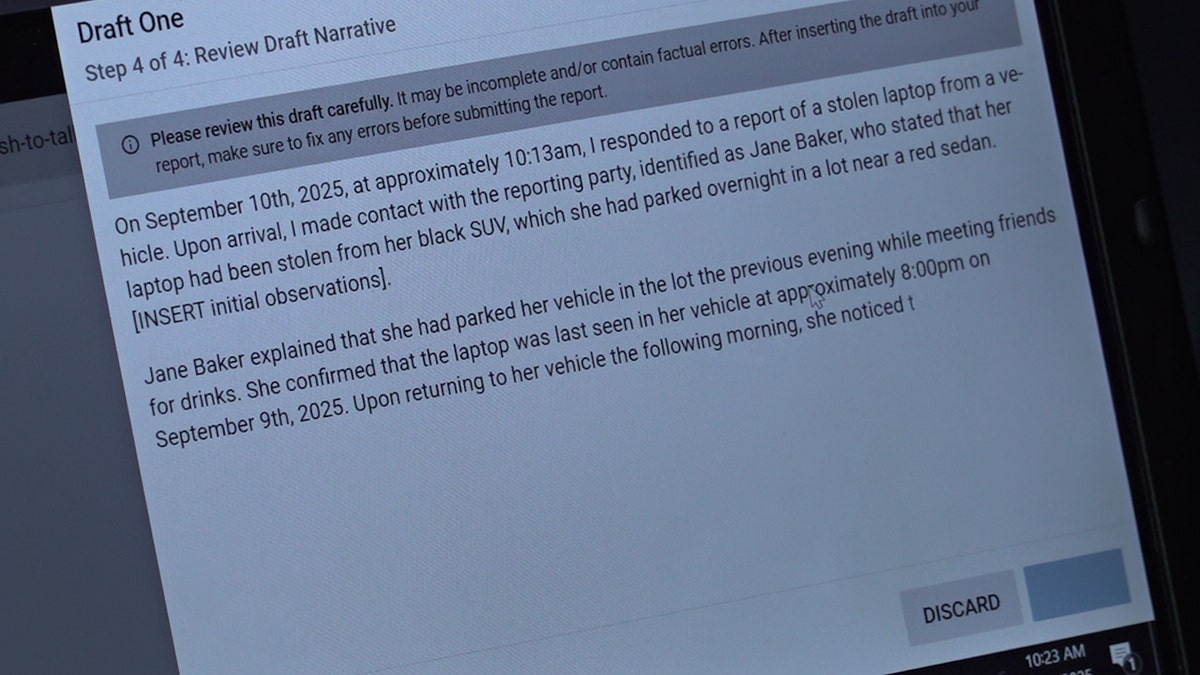
Draft One writes a case report using the recording from an Axon body camera. (Amalia Roy)
“Recently, we saw a detective from our criminal investigative division use AI to identify a deceased unidentified person,” Ogden said. “We’re also looking for ways to increase the productivity and efficiency of our patrol deputies and some of our corrections officers.”
Law enforcement agencies across the country are evaluating how artificial intelligence could help their departments, especially when dealing with resource shortages.
SCHOOLS TURN TO AI GUN DETECTION FOR SAFETY
“A lot of policing agencies are budget constrained. It is very attractive to them to have a tool that could allow them to do more with less,” said Max Isaacs from The Policing Project, which is a non-profit within NYU School of Law that studies public safety and police accountability.
Isaacs said while AI offers opportunities to save resources, there’s not much data on how much help these programs truly provide.
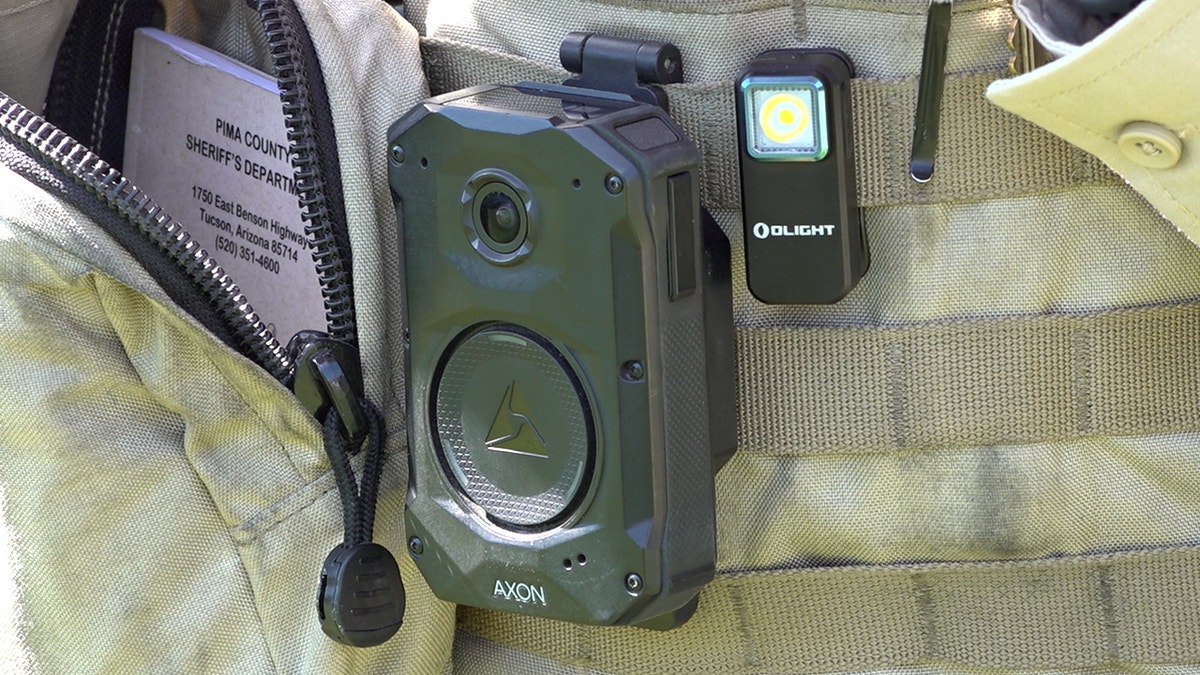
A Pima County deputy wears an Axon body camera in a simulation of an emergency call. (Amalia Roy)
“You have a lot of examples of crimes being solved or efficiencies being realized,” Isaacs said, “But in terms of large-scale studies that rigorously show us the amount of benefit, we don’t have those yet.”
TRUMP SIGNS EXECUTIVE ORDER TO HARNESS AI IN FIGHT AGAINST CHILDHOOD CANCERS
Isaacs also raised the issue of accuracy.
“AI is not perfect. It can rely on data that is flawed. The system itself could be flawed. When you have errors in AI systems, that can lead to some pretty serious consequences. It can lead to false arrests. It could lead to investigators going down a dead end and wasting time and resources,” Isaacs said.
Addressing those concerns, Ogden agreed that information can be flawed. He said it’s why human eyes must review every report written with Draft One.
After a successful trial with 20 deputies, Ogden said the next step is to expand Draft One to corrections officers.
Technology
Hollywood has no idea what to do about AI

This is an excerpt of Sources by Alex Heath, a newsletter about AI and the tech industry, syndicated just for The Verge subscribers once a week.
This week, I got an up-close look at how far apart Silicon Valley and Hollywood are on what to do about AI.
First, at OpenAI DevDay, Sam Altman presented the new Sora app as a gift to content creators. If anything, he suggested, OpenAI was being too censorious by not allowing people to make even more kinds of AI videos.
“On the whole, creators, rights holders, people are very excited about the potential of this,” Altman said during a media Q&A in San Francisco on Monday that I attended. “They believe it will deepen connection. It’s kind of like a new generation of fanfiction.”
The next day, I arrived at Bloomberg’s Screentime event in Los Angeles to hear how media executives, agents, and studio heads felt about the AI meteor that’s heading their way. Sora had just hit 1 million downloads in the App Store and was top of mind for everyone. Altogether, I came away with the impression that Hollywood’s leaders still have no idea what to do about the risk AI poses, and they’re going to be steamrolled by technology that’s moving faster than they can comprehend.
Paramount Skydance CEO David Ellison called AI a “new pencil” to create with
I lost count of how many times a version of the phrase “we care about copyright” was invoked at Screentime like a prayer. At the same time, no one at the event wanted to specifically address the fact that OpenAI clearly trained on their IP without permission and unleashed a product that, at least initially, had no shame in making that clear. The fact that Hollywood’s leaders are unable to share a public perspective on this issue, or more importantly, what they are going to do about it, should be alarming to everyone working in the business.
While onstage, Netflix co-CEO Greg Peters completely dodged a question from Bloomberg’s Lucas Shaw about Sora specifically, and instead waxed about the more boring ways that AI is being used throughout nearly every part of the production process. Paramount Skydance CEO David Ellison also chose to tout the less controversial, tool-like aspect of AI, calling it a “new pencil” to create with. The only executive I heard come close to addressing the real issue on everyone’s minds was Warner Music CEO (and former YouTube exec) Robert Kyncl, who made clear that Warner’s content must be licensed to train on, and that there will be repercussions for those who don’t follow the rules.
It’s not surprising that the music industry has a stronger perspective than, say, the hemming and hawing about AI currently being done by the big talent agencies. The labels are better positioned to take on AI companies as a consolidated group of players who have navigated a version of this problem before with the rise of music streaming. Kyncl went so far as to predict that AI will benefit the music industry long-term, similar to how YouTube eventually solved its copyright problem and evolved into a major distribution platform for the entertainment industry.
He may be right about music specifically, but the lack of collective action from the rest of Hollywood means that the AI companies are poised to keep getting away with asking for forgiveness instead of permission. OpenAI’s decision to train Sora in this manner was a deliberate choice, not an accident, and it showed a complete lack of regard for the implications of sucking up everyone’s content to feed its AI. Altman is simply following the same playbook the tech industry has used in the past to achieve dominance, so who can blame him this time?
-

 Wisconsin2 days ago
Wisconsin2 days agoAppleton Public Library wins 2025 Wisconsin Library of the Year award for distinguished service
-

 West Virginia3 days ago
West Virginia3 days agoWest Virginia eatery among Yelp’s “outrageous outdoor dining spots”
-
Virginia2 days ago
Match 13 Preview: #8 Virginia
-

 Vermont2 days ago
Vermont2 days agoFeds: Springfield dealer ran his drug business from Vermont jail
-
Business2 days ago
Los Angeles Times Media Group takes step to go public
-
Utah2 days ago
Bookmark this link for The Southern Utah Tribune e-edition
-
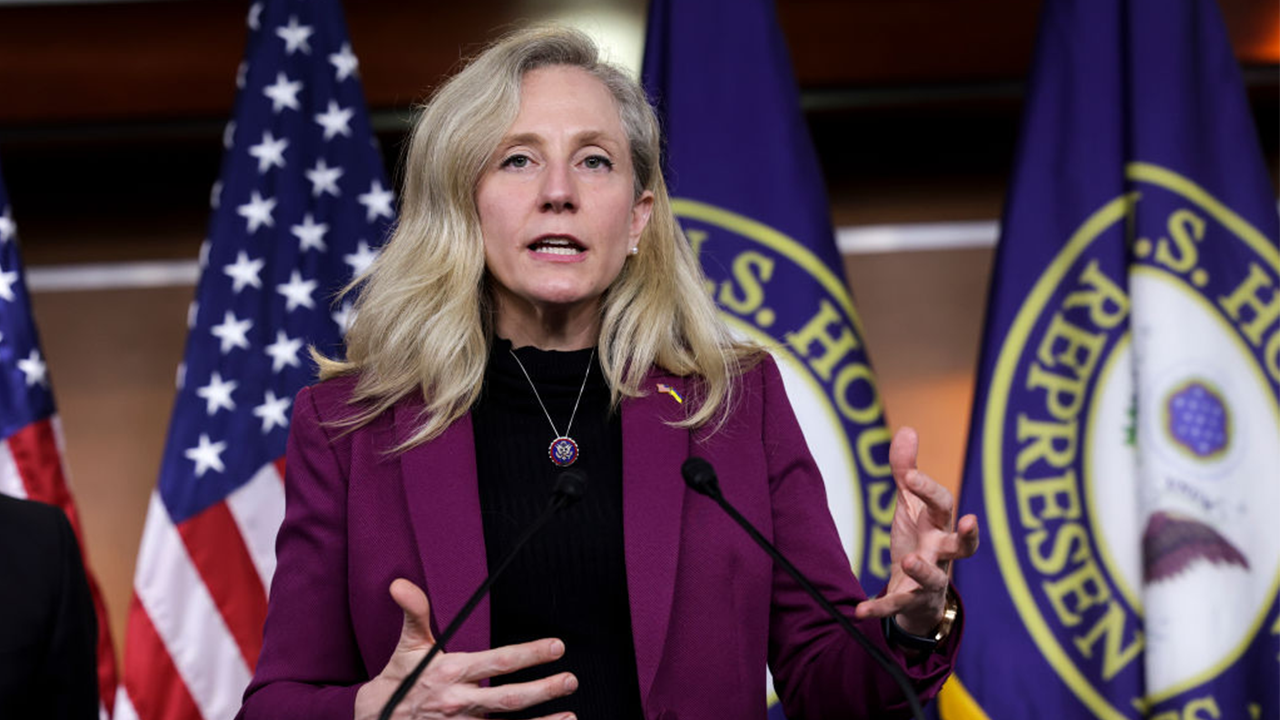
 Politics2 days ago
Politics2 days agoSpanberger refuses to urge Jay Jones to exit race, dodges questions after ‘two bullets’ texts
-

 Midwest2 days ago
Midwest2 days agoWisconsin ski park faces lawsuit after allegedly firing employee for sharing Bible verses on social media



